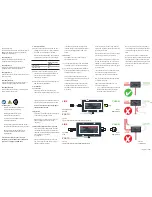
44
Glossary
802.11g
A part of the IEEE802.11 standards for
wireless network communication using the
2.4 GHz frequency band
The maximum communication bit rate is 54
Mbps.
802.11a
A part of the IEEE802.11 standards for
wireless network communication using the 5
GHz frequency band. The maximum
communication bit rate is 54 Mbps.
Advertisement
Protocol for identifying one’s own interface
on a network
DHCP (Dynamic Host Configuration
Protocol)
The feature to assign an IP Address
automatically to a device connected to a
network. The DHCP server does not assign a
fixed IP Address but assigns the IP Address
to each device according to the situation.
Primary DNS (Domain Name System)
Server
A server to identify the IP Address with the
host name (computer name). Normally, a
DNS server specified as Primary is used.
Secondary DNS Server
A substitute DNS Server enabled when a
Primary DNS Server cannot be used
EAP (Extensive Authentication
Protocol)
A protocol adopted as the IEEE802.1x
authentication protocol
IP Address
An address to identify each device on the
TCP/IP network
LAN (Local Area Network)
A network to be used in a limited area, such
as an office or home
MAC address
An individual address to be assigned to an
individual network interface when it is
manufactured. Every interface has a
different MAC address, and you cannot
change the address.
NTP Server
A server to synchronize the clocks of the
devices connected to a network using NTP
(Network Time Protocol)
PEAP (MS-CHAP v2)
This protocol provides authentication based
on qualification information.
PJ Link
A standard to operate and manage the Data
Projectors
POP Server
A protocol used when e-mail is transmitted
on the Internet.
SMTP (Simple Mail Transfer Protocol)
Server
A protocol used when e-mail is received
from an e-mail server on the Internet.
SNMP (Simple Network Management
Protocol)
A protocol used to monitor and control
devices connected over a network
SSID (Service Set Identifier)
Identification data for a wireless LAN that
enables connection with other wireless
devices on the LAN. All wireless LAN
devices employing the same SSID can
communicate with one another.
TKIP (Temporal Key Integrity
Protocol)
An encryption protocol that is the successor
of WEP. TKIP is designed to create a new
encryption key with every certain amount of
data and time then encrypt the data. It
provides stronger security for the data, since
such dynamic change of the encryption keys
renders any encryption of the key absolute.
WEP (Wired Equivalent Privacy)
A security standard that is designed to
encrypt data for communication between
connected devices. Registering the same key
with the projector as that registered with the
Summary of Contents for 4-125-572-12 (1)
Page 47: ...Sony Corporation ...




































